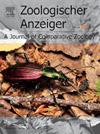巴西东南部Canastra山区溪流中Cambeva微特有种的综合分类研究(志留虫目:毛虫科)
IF 1.5
3区 生物学
Q2 ZOOLOGY
引用次数: 0
摘要
在巴西东南部的山区记录了大量的地方性毛癣鲶鱼。本研究旨在调查坎纳斯特拉山脉和格兰德河右岸之间狭长地带溪流中Cambeva variegata复合体(CVC)种群的分类状况。在这里,我们将单焦点物种划分分析结果(GMYC, PTP, ASAP使用CYTB, 1025 bp)与形态学数据(外部形态学和骨学)相结合。所有的分析都得出了相同的结果,在研究区域划定了四个新物种。结果表明,研究区内的物种不构成单系群。通过形态学特征的组合和独特的核苷酸替换,除了偶尔可能的独特形态学特征状态外,还可以诊断新种。在邻近地区出现的四种短距离物种表明了一种微型地方性物种,这对保护生物多样性非常重要,因为微型地方性物种往往更容易灭绝,而且这些物种中至少有三种出现在有明显生境退化迹象的环境中。需要进一步的研究来精确地确定它们栖息地的条件和地理范围。本文章由计算机程序翻译,如有差异,请以英文原文为准。
Integrative taxonomy revealing microendemic species of Cambeva (Siluriformes: Trichomycteridae) in streams draining Serra da Canastra, southeastern Brazil
A large concentration of endemic trichomycterine catfish species has been recorded in mountainous regions of southeastern Brazil. The present study aims to investigate the taxonomic status of populations of the Cambeva variegata complex (CVC) in streams situated in a narrow strip between the Serra da Canastra and the right bank of the Rio Grande. Here we combined results of unilocus species delimitation analyses (GMYC, PTP, ASAP using CYTB, 1025 bp) with morphological data (external morphology and osteology). All analyses yielded identical results, delimiting four new species in the study area. The resulting tree topology indicated that the species from the study area do not form a monophyletic group. The new species were diagnostic by combinations of morphological characteristics, as well as unique nucleotide substitutions, besides occasionally, when possible, by unique morphological character states. The occurrence of four short-ranged species in neighbouring areas indicates a case of micro-endemism, which is of great importance for biodiversity conservation, since micro-endemic species are often more susceptible to extinction and at least three of these species occur in environments with clear signs of habitat degradation. Further studies are needed to precisely determine conditions and geographical extent of their habitats.
求助全文
通过发布文献求助,成功后即可免费获取论文全文。
去求助
来源期刊

Zoologischer Anzeiger
生物-动物学
CiteScore
2.80
自引率
7.10%
发文量
75
审稿时长
>12 weeks
期刊介绍:
Zoologischer Anzeiger - A Journal of Comparative Zoology is devoted to comparative zoology with a special emphasis on morphology, systematics, biogeography, and evolutionary biology targeting all metazoans, both modern and extinct. We also consider taxonomic submissions addressing a broader systematic and/or evolutionary context. The overall aim of the journal is to contribute to our understanding of the organismic world from an evolutionary perspective.
The journal Zoologischer Anzeiger invites suggestions for special issues. Interested parties may contact one of the editors.
 求助内容:
求助内容: 应助结果提醒方式:
应助结果提醒方式:


